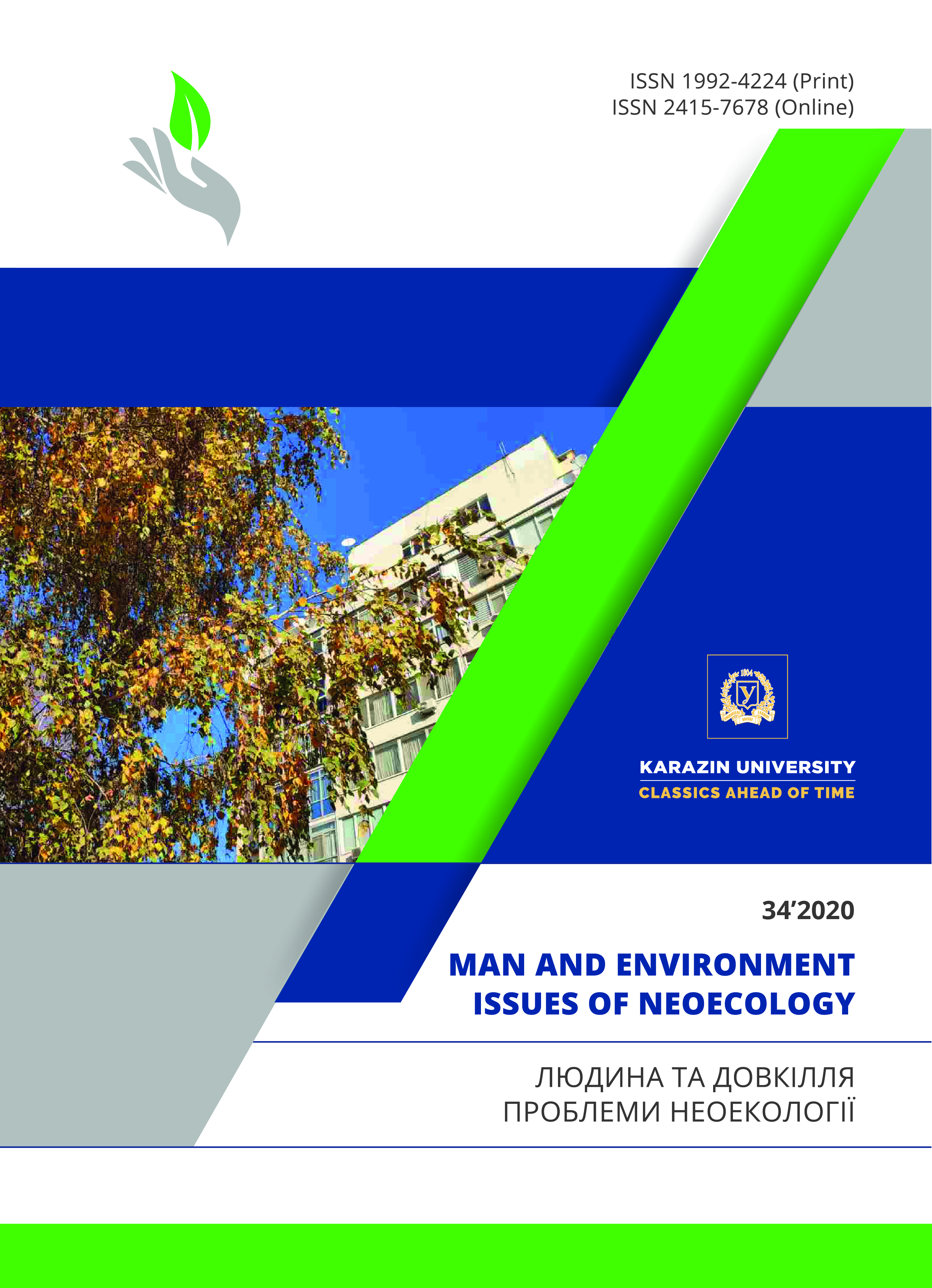The Study of Condition of the South Bug River Basin with Using Geoecological Methods
Abstract
Purpose. Assess the current state of the Southern Bug River basin and the degree of anthropogenic impact on it (transformation)
Methods. The methodology of complex field geographic research (according to S. Kurlov) was chosen for the research. On its basis, water samples were taken at the appropriate points of the river basin, which directly covered the Southern Bug River itself, as well as its tributaries, and the composition of coastal soils was analyzed. Laboratory experiments were performed on the basis of a licensed laboratory of the Uman National University of Horticulture
Results. Based on the analysis of the data set of the main hydrochemical indicators of the surface water quality of the Southern Bug river basin and the analysis of the soil, it was found at some experimental points that the MPC content of the studied indicators was exceeded. The content is exceeded at all sampling points, due to the high content of complexes with humic acid salts, secondary waterlogging of reclaimed lands. The nitrite content is exceeded in the following places: r. Southern Bug (Vinnitsa and Ladyzhin), r. Ustya (Nemyriv), r. Udych
litskiy district) and r. Dohna (Bershad district). The main reason for the intake of nitrates into the water is the washout of fertilizers from fields and vegetable gardens. All surface water bodies have increased water hardness, its acidity is within normal limits. The soils adjacent to the streams under consideration bear clear signs of hydrogenic accumulation of substances (carbonates, gypsum, salts) and deltaic conditions of formation (horizontal stratification, horizons buried, remnants of freshwater fauna).
Conclusions. The concentration of pollutants increases with the approach of the tributaries of the Southern Bug River and the relief formed by them to their base of erosion. Excess concentrations of alkaline hydrolyzed nitrogen, as well as phosphorus and potassium compounds at the sampling points indicate a high level of intensity of the farming system, in which the use of agrochemicals is given priority. However, long-term ingress of these compounds into the water body will accelerate the process of eutrophication in the near future. The loss of humus in the soils of agricultural lands adjacent to the rivers Sob, Dokhna, Ustya was revealed. In general, the geosystem of the Southern Bug River suffers from a complex anthropogenic impact, the main source of which is agricultural production.
(Tep-
Downloads
References
Artayev, O.N., Bashmakov, D.I., Bezina, O.V., Bolshakov, S.Y. … Chikhlyaev, I. V. (2014). Methods of field ecological research: textbook. Saransk: Mordov Publishing House. University. Retrieved from https://docplayer.ru/37487977-Metody-polevyh-ekologicheskih-issledovaniy.html (In Russian).
Mikhailova, E.G. (2015). Aquatic biological resources as common resources. Research. Vod. Biol. Re-sources of Kamchatka and North-West. Parts of the Pacific. Ocean., (36), 79-86. Retrieved from http://kamniro.vniro.ru/publishing/jornal/vypuski_zhurnala/vypusk_36 (In Russian).
Grinevetsky, V.T., Davidchuk, V.S., Shevchenko, L.M., Sorokina, L.Yu., Chekhniy,V.M. & Golubtsov, O.G. (2017). Landscape Studies at the Institute of Geography of the National Academy of Sciences of Ukraine.
Ukrainian Geographical Journal, (4), 3–12. Retrieved from http://www.irbisnbuv.gov.ua/cgibin/irbis_nbuv/cgiirbis_64.exe?I21DBN=LINK&P21DBN=UJRN&Z21ID=&S21REF=10&S21CNR=20&S21STN=1&S21FMT=ASP_meta& (In Ukrainian).
Grodzinsky, M.D. (1995). Resistance of geosystems to anthropogenic loads. Kyiv: Likei. (In Ukrainian).
Gutsulyak, V.M. & Prysakar, V. B. (2004). Assessment of the ecological situation in landscape complex-es (general approaches and methods). Ukraine: geographical problems of sustainable development. Retrieved from https://scholar.google.com/citations?user=BlE6-V4AAAAJ&hl=en_GB (In Ukrainian).
Isachenko, A.G. (1991). Landscape and physical-geographical zoning. Moscow: Higher school. (In Rus-sian).
Preobrazhensky, V.S. (1996). Landscape research. Moscow: Nauka. (In Russian).
Shishchenko, P.G. (1999). Principles and methods of landscape analysis in regional design. Кyiv: Phyto-social center.(In Russian).
Sokolov, A.S. (2018). Methods of geoecological research: methodological bases and classification of geoecological research: a practical manual. Gomel: GSU named after F. Skorina. (In Russian).
Zalizniak, Ya.I. (2019).The main problems of transformation of river geosystems in Vinnytsia region due to anthropogenic impact. Scientific notes of Vinnytsia State Pedagogical University named after Mykhai-lo Kotsyubynsky. Series: Geography, 31(3-4). Retrieved from http://eprints.zu.edu.ua/31714/1/NZ_31.3-4.pdf (In Ukrainian).
Kurlova, Z., Slobodyanyuk, T. & Ruda V. (2018). Methods of complex field geographical research (De-partment of Earth Sciences): teaching method. Publications. Kyiv. Retrieved from http://man.gov.ua/files/49/Metodyka_polovykh_dosl.pdf (In Ukrainian).
GOST 4151–72. Drinking water. The method of determining the total stiffness. (1974). Retrieved from http://docs.cntd.ru/document/1200012550 (In Russian).
Vaganov, I.I., Maevskaya, I.V. & Popovich M.M. (2014). Engineering geology and environmental protec-tion Textbook. Vinnytsia: Vinnytsia National Technical University (VNTU). Retrieved from https://press.vntu.edu.ua/index.php/vntu/catalog/download/126/221/251-1?inline=1 (In Ukrainian).
Dobrovolskiy G.V., Balabko, P.N., Stasiuk, N.V. & Bykova, E.P. (2014). Alluvial soils of river flood-plains and deltas and their zonal differences. Arid ecosystems, 17 (348), 5-13. Retrieved from http://aridecosystems.ru/wp-content/uploads/2019/01/%D0%90%D1%80%D0%B8%D0%B4-%D1%8D%D0%BA%D0%BE%D1%81%D0%B8%D1%81%D1%82_All-number__%D1%82.17_-%E2%84%96348_2011.pdf (In Russian).
Authors reserve the right of attribution for the submitted manuscript, while transferring to the Journal the right to publish the article under the Creative Commons Attribution License 4.0 International (CC BY 4.0). This license allows free distribution of the published work under the condition of proper attribution of the original authors and the initial publication source (i.e. the Journal)
Authors have the right to enter into separate agreements for additional non-exclusive distribution of the work in the form it was published in the Journal (such as publishing the article on the institutional website or as a part of a monograph), provided the original publication in this Journal is properly referenced
The Journal allows and encourages online publication of the manuscripts (such as on personal web pages), even when such a manuscript is still under editorial consideration, since it allows for a productive scientific discussion and better citation dynamics (see The Effect of Open Access).





